It is very essential for you to do periodic audit of your ppc campaign. Even if you have considered all the best practices and your campaign is working very well, still you may possibly miss out something. In that case, audit saves you from falling into a trap which is still not known to you.
In this article, I will focus on each point one by one you need to consider while doing the audit. It will further help you serve White label PPC solutions to your client.
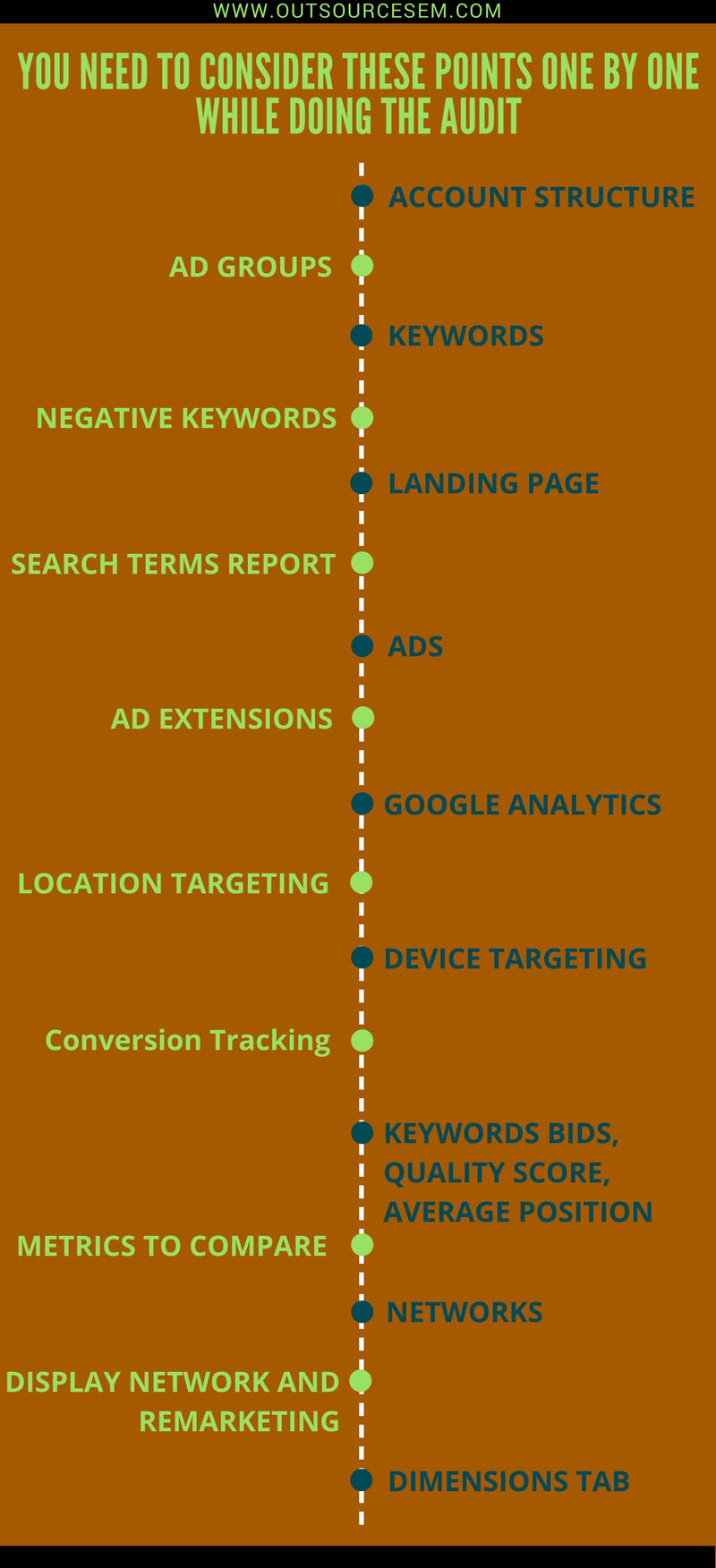
Account structure - The first thing to look at is the naming structure. Campaign names should clearly explain the type of ad groups the campaign has. Your brand keywords should be in different campaign whereas non brand keywords in other campaign. Also separate campaigns geographically if needed.
E.g.

Ad groups – The next things which you should look upon is ad groups. Check whether your ad groups are structured according to the sub-categories of the product and services that you are offering? Your ad group should not include more than 10-20 keywords. As it can make your adcopy writing more difficult which in turns lead to poor quality score and you end up paying more for your clicks. Match type segmentation is one of the most useful styles while structuring your ad groups. Also, it’s considered a bad practice to use all match type of same keyword in same ad group.
Keywords – When auditing keywords, you want to check how many broad vs. exact vs. phrase match terms are being utilized. Check for keyword bids. Is the bid too high or too low to produce result or maintain goals? Also one of the best way of analyzing the keywords is through search term report. We can always pick the keywords which are bringing relevant traffic and paused the ones which are not.
Negative Keywords – Negative keywords can be your life saver against impressions and clicks from unspecified searches. If you don’t have any active campaign then you’ll have to do some guess work for this. But if you already have an active account then you can look into the search term report and pick the ones that seems irrelevant to your services and add them as negative. Also, don’t forget to review the negative keywords which are already present in the account. There might be some keywords in the negative list which is blocking your keywords. Check for negative keyword match types? I have observed this in most of the account that negative keywords are set to exact match type and they are doing absolutely nothing good to the campaign. I prefer adding negatives in broad match.
Landing Page – Does your landing page match the keywords and ads? Is your landing page mobile responsive? Now a days, most of the searches are done on mobile, so it’s very important for you to make your site mobile optimized. Does your landing page look professional? Are there call to actions? Is your content engaging? Are there form on your website? If yes then, are they working properly? Also forms should stand out on the webpage. So that it’s not difficult for them to find it. Are you using same landing page for different product and services? Are you doing A/B testing on your landing pages? You should often do this so as to know what is working for you and what is not.
Search Terms Report - Search term report helps you analyze the terms for which your ads were shown. Knowing these terms can save you a lot of money. It also helps you in increasing your keyword inventory.
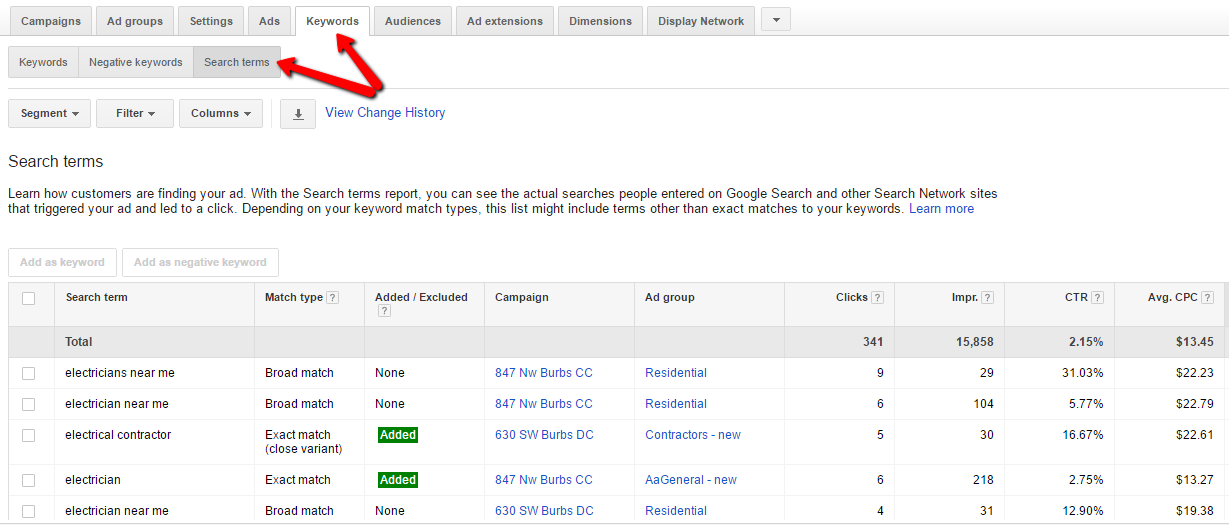
Ads – Once you have analyzed the keywords, next thing which you should look upon is the ad copies. While looking on ad copies you must check whether the ads are relevant to the keywords? Are the keywords included in the ad copy? Are there any exclamation mark in your ads? Are your ads going to relevant landing page? For e.g. If you have mentioned about red roses in your ad but the ad takes you to landing page which talks about lily. Then there can be an issue. How many ads are there in your ad group? I usually prefer 3-4 ads within each ad group. Apart from this don’t forget to check for expired promotions in your ads. Also check that when was ad testing performed last time.
Ad extensions – They are one of the most critical factor in your ppc campaign. So always make sure to have at least one of the following ad extension – Sitelink, call extension, callout extension, location extension, review extension, structured snippet, and app extension.
Google Analytics – Make sure that you have properly connected your Google Ads account with Google analytics. Having both the account linked can save you a lot of money.
Location targeting - There is an option called “geographic location” in dimensions tab which helps you know the name of the location from where you are getting clicks. So this way you can add them as exclusion and avoid irrelevant clicks. The other way of doing it is using the “targeting option”. You can change the targeting option to “people in my targeted location”.

The other thing which you can analyze through this report is you can know which locations are profitable for you and which are not. So that you can create separate campaign for the best performing location and set the budget accordingly. Similarly you can lower the bids for low performing states.
Device Targeting – Check whether it is the mobile device which is getting you more conversions or it is desktop site which is getting you more conversions or its mixture of both.
Conversion Tracking – Conversion tracking is very important if you want to know whether your users are the completing the objective of your website. Infact, it should be your first task after setting up the campaign. So don’t forget to check whether conversion tracking code is generated and implemented correctly on the basis of your company objective. If code has already been implemented then check whether the conversions are being tracked or not in last 30 days. Below are the few pointers which you should look into while checking for conversion code –
• Are you getting same number of clicks and conversions? This is possible only if you provide one of the best services or products available or if you have implemented the code on all the landing pages rather than on Thank you/ confirmation page.
• Your conversion rate is very high as compared to the sales of your product. If this is the case then, maybe it’s because number of page visits is getting tracked rather than the conversions.
• Also check for other conversion codes (like call tracking code) that they are implemented correctly and are getting tracked.
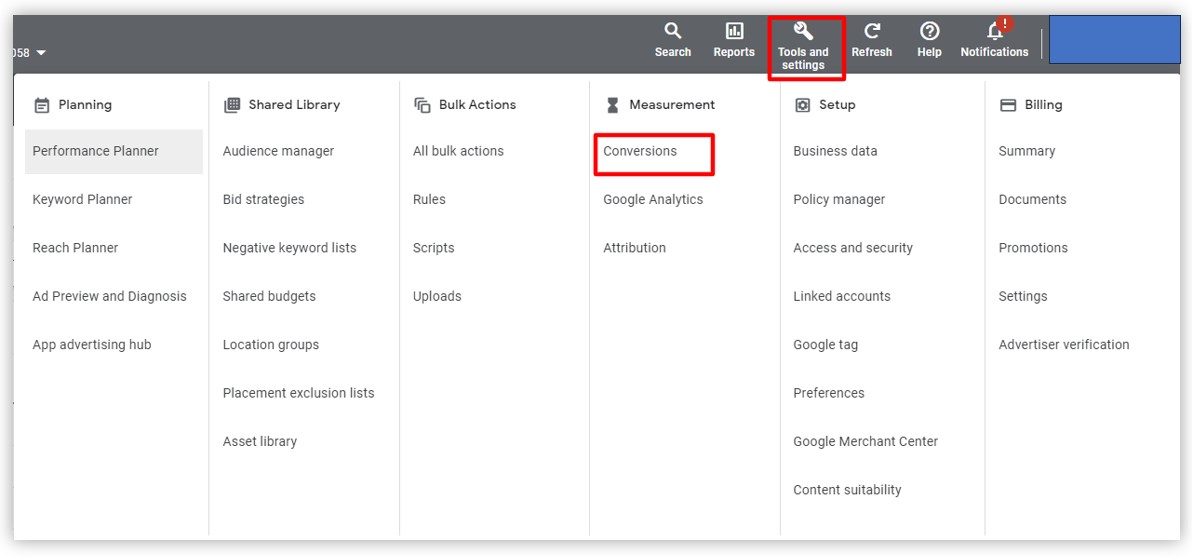
Keywords bids, Quality score, Average position -
• Bids - If your Avg CPC of keywords is close to the max CPC then you can consider increasing your bids slightly to accommodate it. You can also check if the keywords are costing too much and cost per conversion is too high then we should pause the keywords or lower the bids.
• Click Through Rate (CTR) – Click through rate is again one of the most important parameter which you should not miss. Improving your CTR helps you get more conversions. Bids, keywords and ad relevance mostly affects your CTR. So you need to improve these so as to improve your CTR.
• Avg Position – If you have low avg. position then you can consider increasing the CPC or improve the quality score or increase the CPC. Improving your ad position improves your CTR as well because people tend to click more on ads that are at top 3 positions rather than those at the bottom.
• Quality Score – Improving quality score not only improves your average position but also reduces your CPL. Google’s default quality score is 6. So always try improving it if it’s below 6. While analyzing the quality score you should do it at every level – Keyword level quality score, account level quality score, ad level quality score, device quality score, landing page quality score.
• Low Search Volume – These are those keywords which are rarely searched for. You may keep these keywords as it is or pause them if you are getting good number of impressions but not getting any clicks, which can affect your CTR.
• Lost impression share due to budget - Sometimes you will see the notification “limited by budget” and when you click it you see recommendation of increasing the budget. Also if you want to check whether your ads are not losing any impressions due to budget then you can do so by analyzing the “search impression share is budget “metric under competitive metrics column. Increasing your budget in such instance can help your ads to show more often. Now what if you can’t afford to increase the budget? There are lot of other things which you can do –
1. You can allocate some budget from the campaigns that are not limited by budget to those which limited by budget.
2. You can also use “shared budget” across your campaigns so that the budget is allocated on the basis of demand.
3. You can also use ad scheduling so that you spend during times which are most profitable for you.
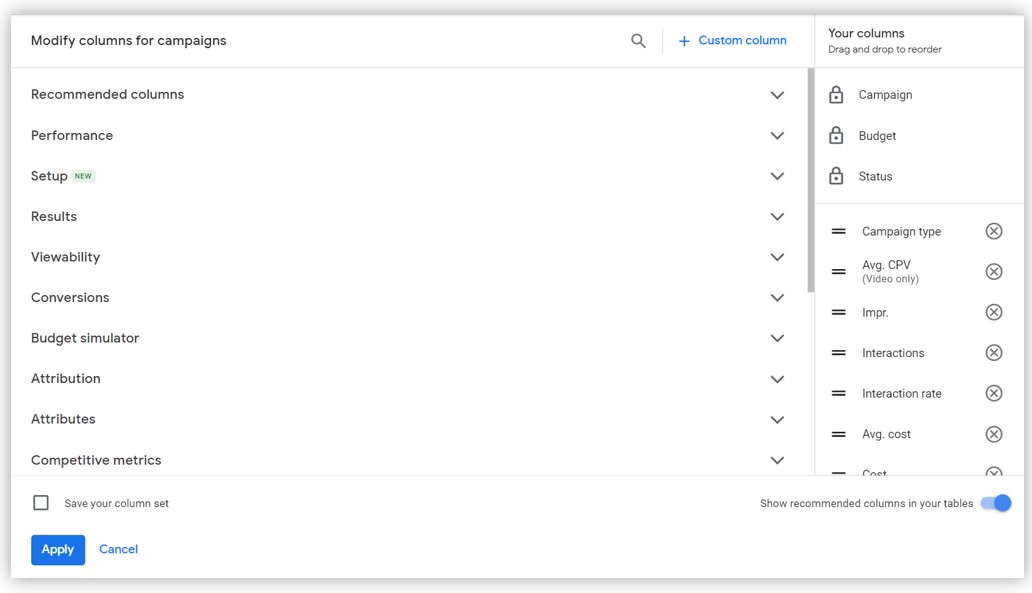
• Lost impression share due to rank – To check if you are losing out your impressions due to rank, you can look “Search lost IS (rank)” metrics. Also you end up paying more for ad clicks. These can be improved by improving Ad rank. You can read more about ad rank and measures to improve it in this “http://www.outsourcesem.com/blog/ad-position-ad-rank.html” article.
• Other metrics – Is your CPA is going high and quality score sliding down? If this is the case, then it’s a red signal for your campaign. Also do you set date range to check performance of your campaign? If not, then don’t forget to do so, especially if seasonality affects your business. For e.g. if New Year or Christmas is your big selling season then compare the data from previous year.
• Relative CTR – Relative CTR is again one of the most important parameter which explains how your ads are performing as compared to your competitors at same website on Google Display Network. For e.g. if your ad has CTR of 0.8 and your competitor’s ad on the same website has CTR of 0.5 then your relative CTR will be CTR of 0.08/ CTR of 0.02 = 4x
Networks – If you are running your campaign on display network then don’t forget to check your placements. Check if all the placements are running automatically or they are in the managed section. Are those placements hitting goals? Check if the placements are hitting goals or not. Are there relevant exclusion?
Display Network and Remarketing -
• Automatic Placements – If you are using automatic placements, then make sure they are performing well. If not then you can pick the sites that has performed very well for you and change the manual placements to automatic placement. Also, you can add poorly performing placements as exclusions.
• Banner Sizes – Check if you have banners in different sizes so that your ad appears in different placements.
• Cookie Implementation - Check if cookie are implemented correctly.
• Remarketing – Are remarketing campaigns implemented? Have you implemented the code correctly on every page of your website? Can you find cookie code in website code? Have all the cookies been set up with length that make sense. This is what you should not miss while checking. Remarketing boosts the conversion rate and also helps in building brand awareness compared to other marketing methods.
Dimensions Tab – This is again very helpful in analyzing your account health. Its helps you analyze your campaign and get a better understanding of how to get most from your target audience.
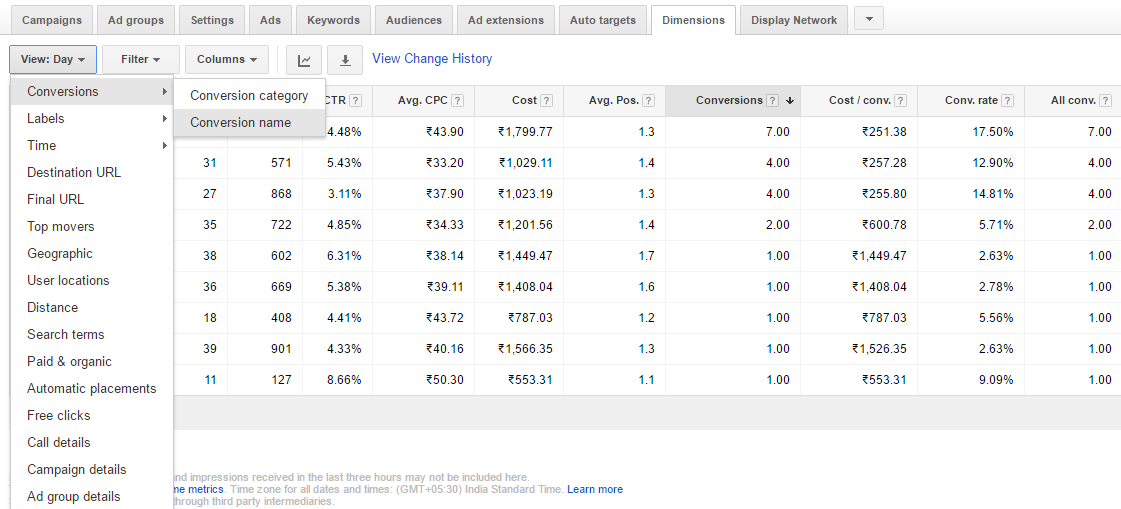
Summary
PPC audit is all about finding opportunities to improve your Google Ads campaign and generate more revenue. Whether it’s analyzing analytics data, checking your campaign performance or fixing your campaign issues, it feels really very great to get return on your efforts. Hope above article helps you while doing the audit of your campaign.
